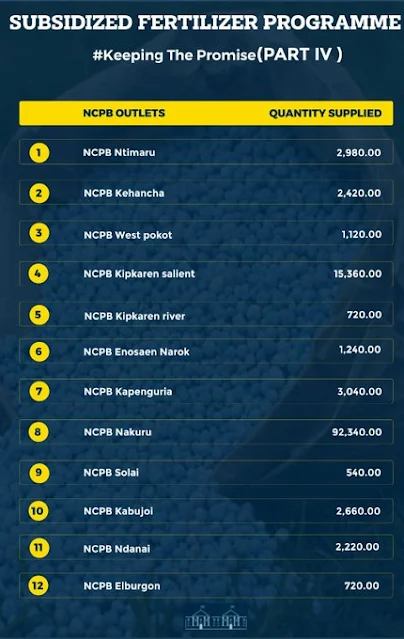 |
| President William Ruto |
The government has fulfilled its promise to farmers. The price of fertiliser has dropped from Shs 7,000 to Shs 3,500 under the Subsidized Fertilizer Program. Distribution under the e-voucher is in top gear.
President William Ruto promised that there would be subsidies targeting the population.
It started with the registration of farmers and their acreage, and now farmers are already getting the fertiliser at cheaper prices, as Bungoma confirms.
"The government is going to deliver all its promises in a systematic way, and that's why this time around they have decided to start with fertiliser subsidies," said an NCPBA official.
The e-voucher system has removed the need for middlemen in the distribution of subsidised fertilizer, ensuring that it reaches its intended recipients.
In Western Kenya (NCPB), where most of the farmers are small-scale farmers who want to get their fertilizer, there are long lines.
With farmers getting the required quality and quantity of fertilizer, the country's food production capacity is expected to double, reducing the cost of food and living in the country.
"The process is straightforward," Fred Simiyu, a farmer in Bungoma, said.
As farmers get the right kind and amount of fertilizer, the country's food production capacity is set to double. This is part of the government's well-thought-out plan to lower the cost of food and, by extension, the cost of living in the country.
Kenya's Kwanza government has promised to subsidise fertiliser for all farmers because there is enough for everyone.
Farmers hope that the government's promised changes to the agricultural sector will help them deal with high production costs and low-quality farm inputs.
Reforming fertiliser subsidies to ensure that they are efficient and transparent and target smallholder farmers remains key to restoring productivity.
Several factors, ranging from erratic rainfall to the high cost of farm inputs to disease outbreaks such as fall armyworm, head smut, and a repeated outbreak of maize lethal necrosis, have contributed to the decline in maize yield.
Annual agriculture reports show that the Rift Valley region has continued to have low yields. Last year, production dropped from 27 million bags to 21 million bags.
The Ministry of Agriculture has forecast that this season’s maize harvest will be 32 million 90-kg bags, 20 Percent less than the projected 40 million bags.
This reversed some of the gains made in reforming the sector, which forms a major part of the country's economy. The increased cost of farm inputs forced many farmers to plant their crops without fertiliser in previous seasons.
For a long time, cartels have exploited farmers with high fertiliser prices. Farmers have been assured by the government that they have enough fertilizer.
It's the first time in history that large-scale farmers are benefiting from a government fertiliser subsidy program.
The distribution, which comes as farmers prepare for planting, is aimed at improving food security in the country, which is key to President William Ruto’s administration.
The ready-made database will give farmers managed access to government programmes and enhance openness, accountability, and traceability in the operation of fertiliser subsidy schemes.
The Bungoma farmer said that "because Kenya is constantly dependent on food that is generated by our farmers, Kenya Kwanza opted to deliver on this pledge first in order to guarantee that we are covered in food production."
If farmers get the right kind and amount of fertilizer, it is expected that the country's ability to produce food will double.
This will result in a decrease in the cost of food and living in the country.
"What I love about the distribution of subsidised fertilise this time is that even the small-scale farmers can access it easily, even if it's just one bag," Fred added.
Throughout the previous eight years, Kenya's maize output has been very variable, with the greatest year being 2018 with 44.6 million bags and the lowest year being 2017 when the nation produced just 35.4 million bags of the staple crop.
The highest production year was 2018, with 44.6 million bags. According to the statistics compiled by the Kenya National Bureau of Statistics, farmers produced 40.7 million bags in 2013, 39 million bags in 2014, 42.5 million bags in 2015, 37.8 million bags in 2016, and 39.8 million bags in 2019.
Every farmer is receiving precisely the same quantity of bags that they requested throughout the registration process.
The Kenya Kwanza Government has made it a priority to subsidise agricultural output as one of the methods to raise productivity, reduce the cost of living, and ensure that our country will always have access to sufficient food supplies.
This government is going to deliver all their promises in a systematic way and that's why this time round they have decided to start with fertilizer subsidies. #FertilizerPromiseDelivered
— Queen Of The South (@___Achieng) February 23, 2023
Tuliahidi Tumetimiza @WilliamsRuto @UDAKenya @OleItumbipic.twitter.com/muNQqlS4Lq


إرسال تعليق
What is your say on this